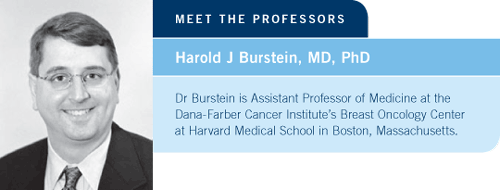
| Tracks 1-7 |
| Track 1 |
Introduction |
| Track 2 |
Clinical implications of adjuvant
trastuzumab trial results |
| Track 3 |
Management of low-risk
HER2-positive disease |
| Track 4 |
Adjuvant trastuzumab
monotherapy |
|
| Track 5 |
Delayed adjuvant trastuzumab |
| Track 6 |
Duration of therapy with
adjuvant trastuzumab |
| Track 7 |
Selection of adjuvant hormonal
therapy for patients with
ER-positive, HER2-positive
disease |
|
|
Select Excerpts from the Breast Cancer Update Meet The
Professors Session, held at the 28th Annual San Antonio
Breast Cancer Symposium, December 8-11, 2005
 Track 2-3
Track 2-3
 DR LOVE: Would you summarize the results of the adjuvant
trastuzumab trials? DR LOVE: Would you summarize the results of the adjuvant
trastuzumab trials? |
 DR BURSTEIN: Within a span of eight months, the results from a number of
randomized clinical trials, all with a fundamental design of chemotherapy with
or without trastuzumab, were reported.
DR BURSTEIN: Within a span of eight months, the results from a number of
randomized clinical trials, all with a fundamental design of chemotherapy with
or without trastuzumab, were reported.
This experience cumulatively totals more than 10,000 patients: 3,200 in the
BCIRG trial, roughly 3,000 from the pooled NSABP and Intergroup analysis,
approximately 3,500 from two arms of the HERA trial, and a couple of
hundred from the FinHer study (Slamon 2005; Romond 2005; HERA Study
Team 2005; Joensuu 2005).
I’m sure that at some point, someone will do a meta-analysis, but I don’t believe
it’s necessary because the hazard ratio for risk reduction when trastuzumab is
added in the adjuvant treatment of HER2-positive disease has been remarkably
consistent — approximately 50 percent. When you consider the scale of this
research enterprise and the sample size, that’s really quite astonishing.
It’s also impressive that the absolute benefit has been incredibly consistent.
In all of these trials, the patients who received chemotherapy alone had
approximately a 30 percent risk of recurrence, whereas the patients who
received chemotherapy with trastuzumab had a 15 percent risk.
 DR LOVE: Can you comment on the data from the BCIRG 006 adjuvant trial
that compared AC followed by docetaxel versus AC followed by docetaxel plus
trastuzumab versus docetaxel, carboplatin and trastuzumab?
DR LOVE: Can you comment on the data from the BCIRG 006 adjuvant trial
that compared AC followed by docetaxel versus AC followed by docetaxel plus
trastuzumab versus docetaxel, carboplatin and trastuzumab?
 DR BURSTEIN: The seminal question for that trial was how the triplet
— docetaxel, carboplatin and trastuzumab (TCH) — would compare with
AC followed by docetaxel/trastuzumab and whether we could avoid using an
anthracycline.
DR BURSTEIN: The seminal question for that trial was how the triplet
— docetaxel, carboplatin and trastuzumab (TCH) — would compare with
AC followed by docetaxel/trastuzumab and whether we could avoid using an
anthracycline.
Although the numbers were not statistically significant, it struck me that there
is still an advantage for the anthracycline-based chemotherapy. The tradeoff
that Dr Slamon reported is that there seems to be a slightly greater risk of
cardiac toxicity for the women who received the anthracycline-based regimen,
but only about a one percent difference in terms of clinical cardiotoxicity
events.
I think the TCH regimen is provocative, and we should continue to watch
the data as they mature. However, for the moment I will continue to use AC
followed by taxane with trastuzumab as my principal adjuvant regimen for
HER2-positive disease.
 DR LOVE: What are your thoughts about the TOPO II data that Dr Slamon
introduced?
DR LOVE: What are your thoughts about the TOPO II data that Dr Slamon
introduced?
 DR BURSTEIN: TOPO II is a gene locus that’s on the same chromosome as
the HER2 gene locus, and when there is amplification of HER2, sometimes
those amplicons, that stretch of DNA that gets amplified, include the TOPO
II gene. Dr Slamon showed that the patients whose tumors are particularly
enriched for TOPO II seem to selectively benefit from the anthracycline-based
chemotherapy.
DR BURSTEIN: TOPO II is a gene locus that’s on the same chromosome as
the HER2 gene locus, and when there is amplification of HER2, sometimes
those amplicons, that stretch of DNA that gets amplified, include the TOPO
II gene. Dr Slamon showed that the patients whose tumors are particularly
enriched for TOPO II seem to selectively benefit from the anthracycline-based
chemotherapy.
I think that is a provocative finding, and it fits with a good deal of preclinical
and clinical literature. However, for the moment, it is not a commercially available
test nor, frankly, one that is commercially necessary, because I think most
patients should still get the anthracycline-based, trastuzumab-based regimen.
 DR LOVE: How do you manage a HER2-positive tumor smaller than one
centimeter in the adjuvant setting?
DR LOVE: How do you manage a HER2-positive tumor smaller than one
centimeter in the adjuvant setting?
 DR BURSTEIN: The honest answer is that we don’t know whether these
women need trastuzumab. We do need to be respectful of the fact that these
women have a better prognosis because their tumors are so small. Certainly for
women whose tumors are ER-positive and less than one centimeter, I’ve not
offered trastuzumab.
DR BURSTEIN: The honest answer is that we don’t know whether these
women need trastuzumab. We do need to be respectful of the fact that these
women have a better prognosis because their tumors are so small. Certainly for
women whose tumors are ER-positive and less than one centimeter, I’ve not
offered trastuzumab.
For patients with ER-negative disease, I suppose one could consider trastuzumab,
though the quantifiable gains from adding this agent are not known.
It would be interesting to conduct a study evaluating trastuzumab with or without chemotherapy in patients with very small tumors. Maybe we can
begin to eliminate chemotherapy for the lower-risk patient population if we
can alter the natural history of their disease.
Select publications

